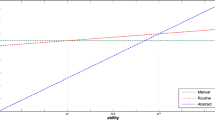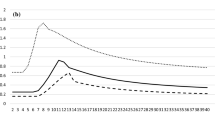Abstract
The acquisition of automation occurs in response to a variety of organizational goals. It follows that different mathematical models are required to capture an organization's specific incentives. In addition, formulations must differ to reflect the characteristics of the automation being considered. Here, a survey of three models developed by the author is presented that considers the optimal dynamic mix of labor and automation. These models differ with respect to (i) the organizational motivations identified for acquiring the automation, (ii) the purpose and use of the automation under consideration, and (iii) the manner in which the automation is acquired over time.
Similar content being viewed by others
References
Y. Balcer and S.A. Lippman, Technical expectations and adoption of improved technology, (Social Systems Research Institute, University of Wisconsin-Madison, 1982).
D.F. Barr, Decision-making on the deployment of new technology — A practical approach, Eur. J. Oper. Res. 11(1982)380.
Bensoussan, Hurst and Naslund,Management Applications of Modern Control Theory (Elsevier, New York, 1974).
A. Blaquiere, Differential games with piece-wise continuous trajectories, in:Differential Games and Applications, ed. H. Hagedorn, H.W. Knobloch and G.J. Olsder (Springer-Verlag, New York, 1977) p. 34.
A. Blaquiere, Necessary and sufficient conditions for optimal strategies in impulsive control, in:Differential Games and Control Theory III, ed. Pan-Tai Lin and E. Roxin (Marcel Dekker, New York, 1981).
T. Boucher, Technical change, capital investment, and productivity in U.S. metalworking industries, in:Aggregate and Industry-Level Productivity Analysis, ed. A. Dogramaci and N.R. Adam (Martinus Nijhoff Publishing, Boston, 1981).
J. Case, Impulsively controlled differential games, in:The Theory and Application of Differential Games, ed. J.D. Grate (Reidel Publishing Co., Boston, 1975) p. 179.
C. Gaimon, The optimal acquisition of flexible automation for a profit maximizing firm, WPS85-52, College of Administrative Science, Ohio State University (1985).
C. Gaimon, An impulsive control approach to deriving the optimal dynamic mix of manual and automatic output, Eur. J. Oper. Res., to be published.
C. Gaimon, The continuous acquisition of automation to reduce production and in-process inventory costs, in:Flexible Manufacturing Systems: Methods and Studies, ed. A. Kusiak, to be published.
C. Gaimon, The continuous acquisition of automation subject to diminishing returns, IIE Trans. 17(1985)147.
C. Gaimon, The optimal acquisition of automation to enhance the productivity of labor, Management Science 31(1985)1175.
C. Gaimon and G.L. Thompson, Optimal preventive and repair maintenance of a machine subject to failure, Optimal Control Applications and Methods 5(1984)57.
B. Gold, CAM sets new rules for production, Harvard Business Review (Nov.–Dec., 1982) 88.
M.P. Groover,Automation, Production Systems, and Computer-Aided Manufacturing (Prentice Hall, New Jersey, 1980).
H. Hinomoto, Capacity expansion with facilities under technological improvement, Management Science 11(1965)581.
A. Houtzeel, Compuer assisted process planning minimizes design and manufacturing costs, Industrial Engineering (Nov. 1981) 60.
J.J. Hughes, G.K. Hutchinson and K.D. Gross, Flexible manufacturing systems for improved mid-volume productivity,Proc. AIIE Systems Engineering Conf., Las Vegas, 1975.
G.K. Hutchinson and G.E. Wynne, A flexible manufacturing system, Industrial Engineering 5(1973)10.
M.I. Kamien and N.L. Schwartz, Some economic consequences of anticipating technical advance, Western Economic Journal 10(1972)123.
M.I. Kamien and N.L. Schwartz, Timing of innovations under rivalry, Econometrica 40(1972)43.
M.I. Kamien and N.L. Schwartz,Dynamic Optimization, Calculus of Variations and Optimal Control in Economics and Management (North-Holland, New York, 1981).
K. Knott and R. Getto, A model for evaluating alternative robot systems under uncertainty, International Journal of Production Research 20(1982)155.
L. Krajewski and L. Ritzman,Operations Management: Strategy and Analysis (Addison-Wesley, Reading, Massachusetts) forthcoming.
E.J. Lerner, Computer-aided manufacturing, IEEE Spectrum (Nov., 1981).
S.P. Sethi and G.L. Thompson,Optimal Control Theory: Applications to Management Science (Martinus Nijhoff, Boston, 1981).
H.A. Tombari, Factors to be considered when evaluating the purchase and use of numerically controlled machine tools, Production and Inventory Management 19(1978)52.
Author information
Authors and Affiliations
Rights and permissions
About this article
Cite this article
Gaimon, C. The dynamical optimal acquisition of automation. Ann Oper Res 3, 59–79 (1985). https://doi.org/10.1007/BF02022059
Issue Date:
DOI: https://doi.org/10.1007/BF02022059




